
PUMPA - SMART LEARNING
எங்கள் ஆசிரியர்களுடன் 1-ஆன்-1 ஆலோசனை நேரத்தைப் பெறுங்கள். டாப்பர் ஆவதற்கு நாங்கள் பயிற்சி அளிப்போம்
Book Free DemoIntroduction:
- Fungi are eukaryotic organisms that include microorganisms like yeasts, moulds and mushrooms. These organisms are classified under kingdom fungi.
- Mycology is the study of fungi with their genetic and biochemical properties.
- They are non-green because they lack chlorophyll which means they cannot produce their food by photosynthesis.
- They are heterotrophic, cannot synthesise their food for their nutritional needs, and depends on the living host or dead and decaying organicmatter. By absorption, they obtain food from their host.
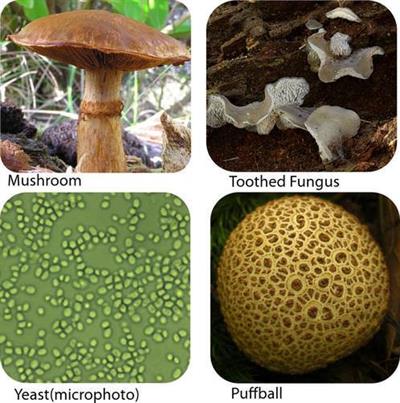
Examples of fungi
Based on nutrition, fungi can be classified into two types.
Parasitic:
The fungi that survive on living hosts are called parasites; they infect the host by causing various diseases. The parasite may live inside the body of the host or lives outside the surface of the host. E.g. Leaf rust, caused by the parasitic fungus called Puccinia triticina, is the most common wheat disease, and Cryphonectria parasitica is a parasitic fungus of chestnut trees.
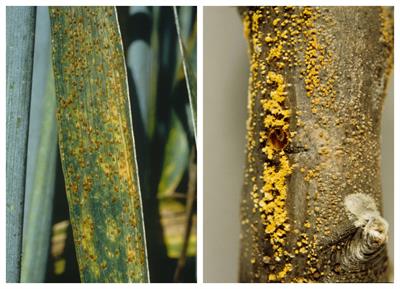
Left to right: Leaf rust disease in a wheat leaf and chestnut blight disease in the stem of chestnut tree
Saprophytic:
The fungi that live and obtain nutrition from dead and organic matter are called saprophytes. Many of the saprophytes are incredibly beneficial because they break down the organic material into humus, minerals, and nutrients that plants can utilise, E.g. Penicillium.
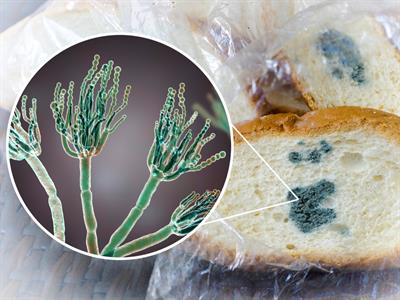
Spoiled bread due to the bread mould
These types of fungi live by having an interdependent relationship association with other species in which both are mutually benefited.
This relationship is significant for plants because certain microorganisms like fungi live in trees' roots. The fungi help the plants absorb water and nutrients from the soil needed for their growth.
This relationship is significant for plants because certain microorganisms like fungi live in trees' roots. The fungi help the plants absorb water and nutrients from the soil needed for their growth.
Example:
A lichen where a symbiotic relationship exists between the fungus and algae.
Structure of fungi:
The body of the fungus is named as thallus. Comparatively in size, fungi are bigger than bacteria. The width of the single-celled yeast ranges from 1-5 μm. Fungi live as either single-celled organisms or multicellular organisms. Single-celled fungi are referred to as yeasts. The majority of fungi are multicellular, E.g. Mold. Fungi are mostly spherical.
Flagella are absent in fungi, and hence they are non-motile (they do not move because they depend on other organisms for nutrients).
Fungi consist of several thin, long thread-like filamentous structures known as hyphae (singular: Hypha). Hyphae are important structures required for growth in these species. The network of hyphae forms a mesh-like, branched tubular structure called mycelium. Hyphae is may or may not be intersected with the cell wall.
Fungi consist of several thin, long thread-like filamentous structures known as hyphae (singular: Hypha). Hyphae are important structures required for growth in these species. The network of hyphae forms a mesh-like, branched tubular structure called mycelium. Hyphae is may or may not be intersected with the cell wall.
Fungi contain a cell wall made up of polysaccharides such as cellulose, hemicellulose, and chitin. Cell wall gives structural rigidity to the fungal cell.
Each hypha is about \(5\) to \(10\) μm wide. They are tube-like structures filled with protoplasm (cytoplasm and nucleoplasm). Cytoplasm consists of a small vacuoles filled with cell sap, nucleus, mitochondria, golgi body, ribosomes and endoplasmic reticulum.
- Cell sap (it contains variable amounts of food and waste materials, inorganic salts, and nitrogenous compounds)
- The Nucleus is membrane-bound, dense, clear, with chromatin threads. A nuclear membrane encompasses the nucleus.
Fungi store their food material in the form of glycogen (a branched polymer of glucose) or oil globules (One of the minute spherules of oil or fat often found as inclusions in the living protoplasm of cells).
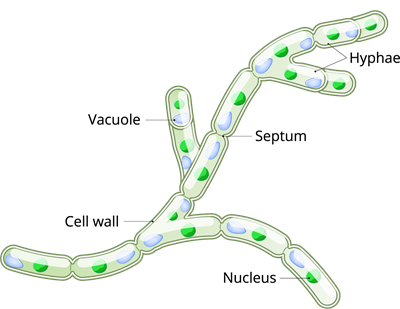
Structure of fungi
Reproduction of fungi happens in three ways.
They reproduce vegetatively by binary fission, budding and fragmentation.
Asexual reproduction:
Asexual reproduction occurs with the help of spore formation called conidia.
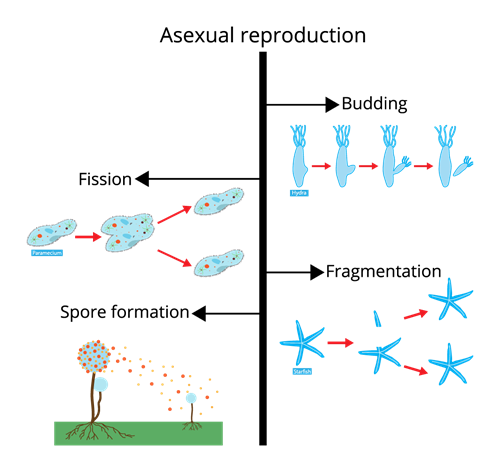
Asexual reproduction of fungi
Sexual reproduction:
Sexual reproduction occurs by the fusion of male gametangium (antheridium) and female gametangium (oogonium).